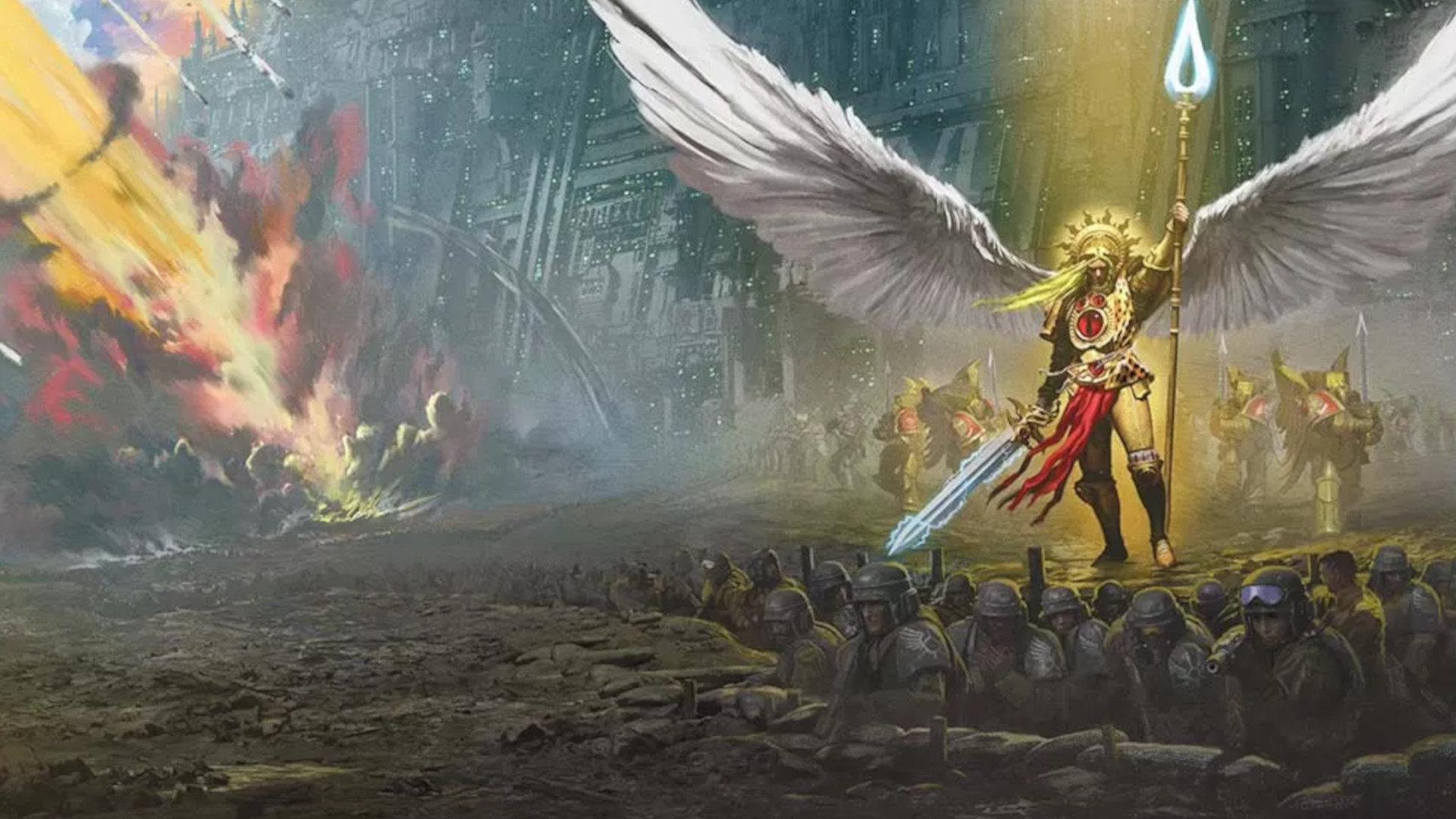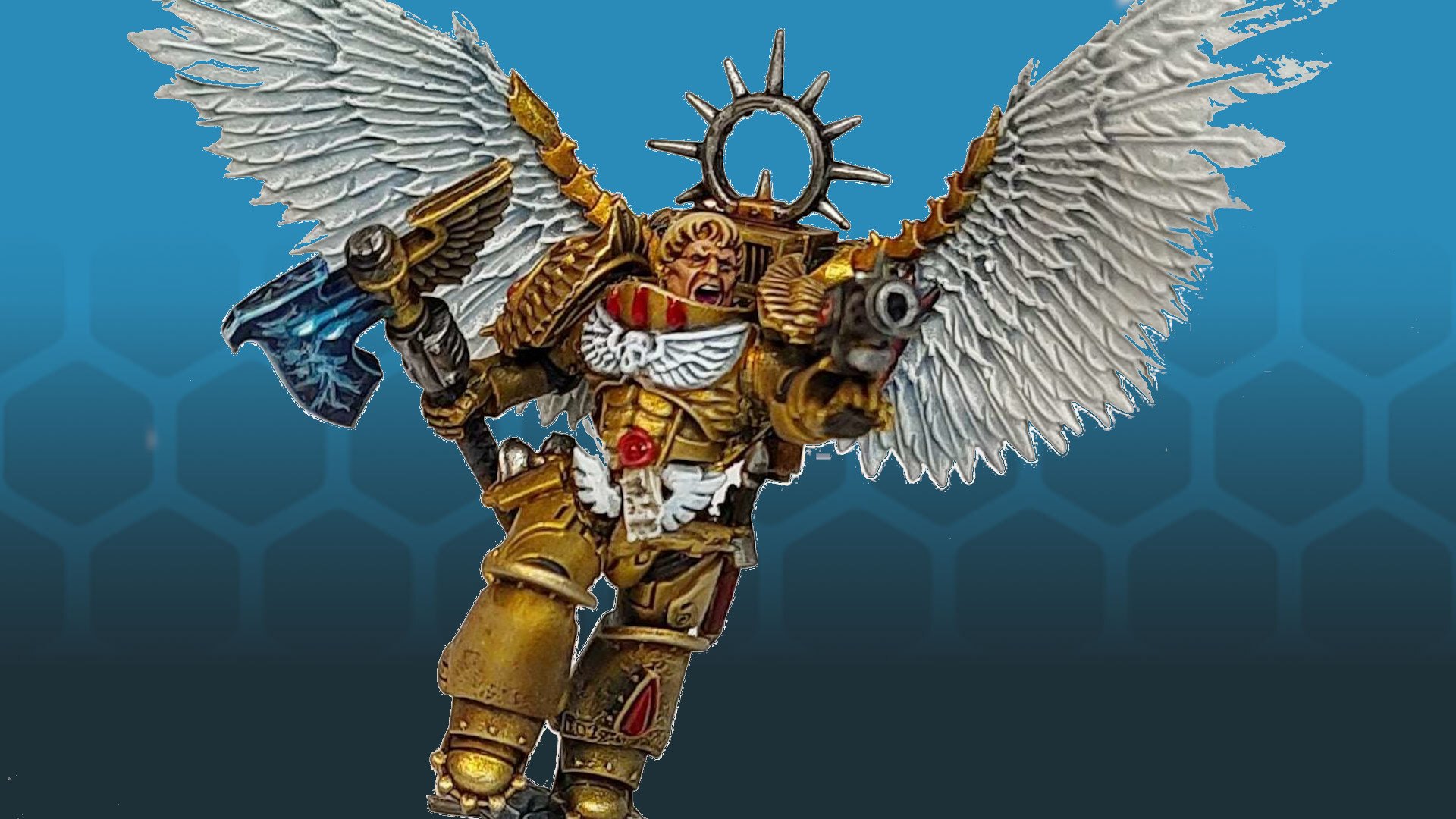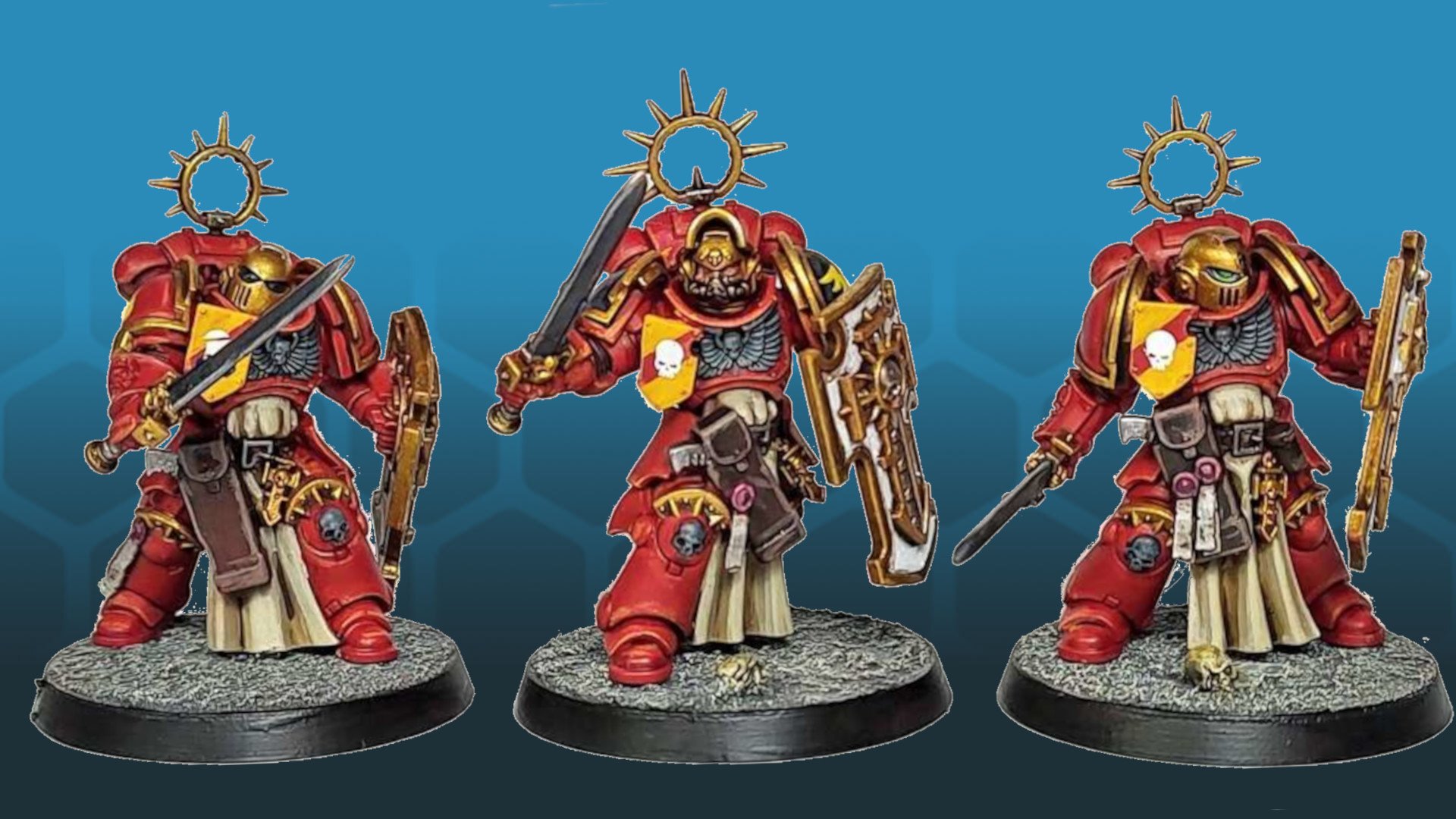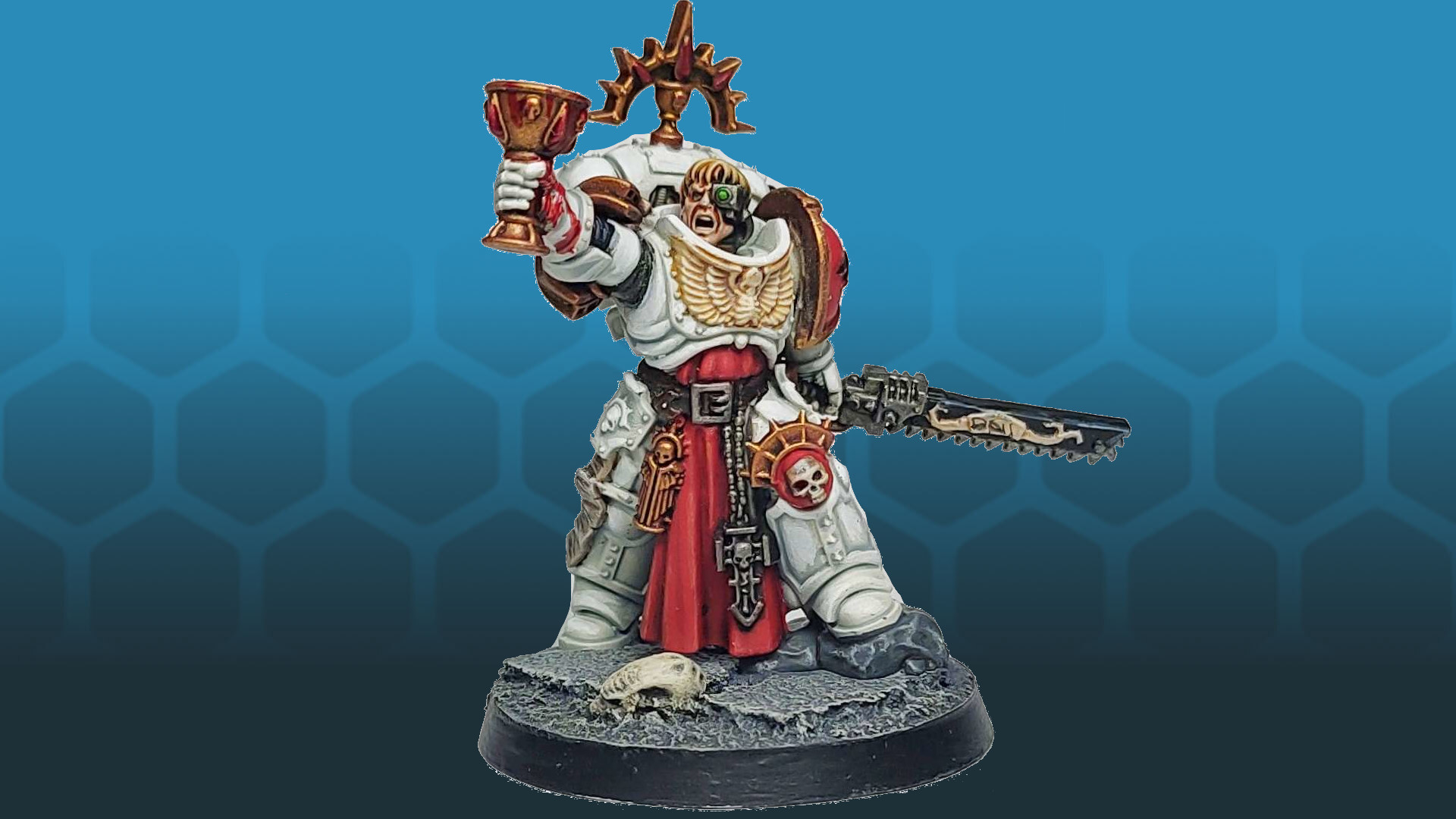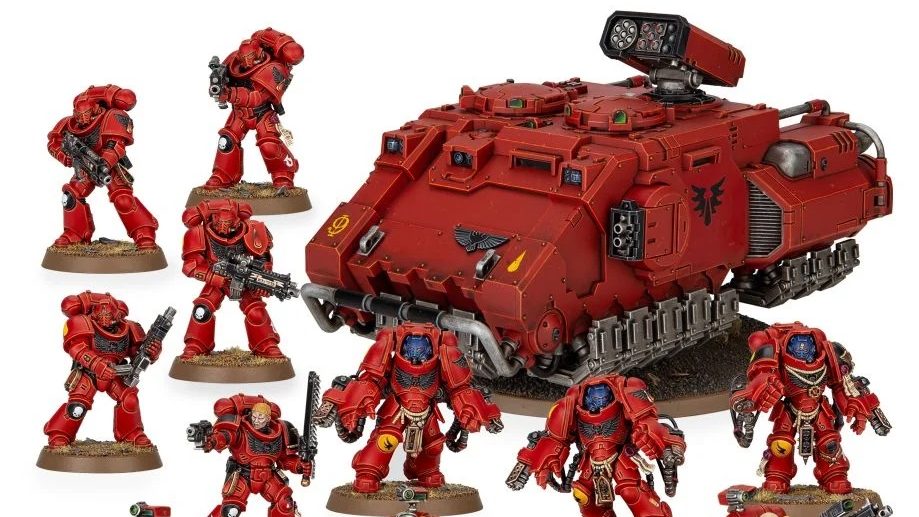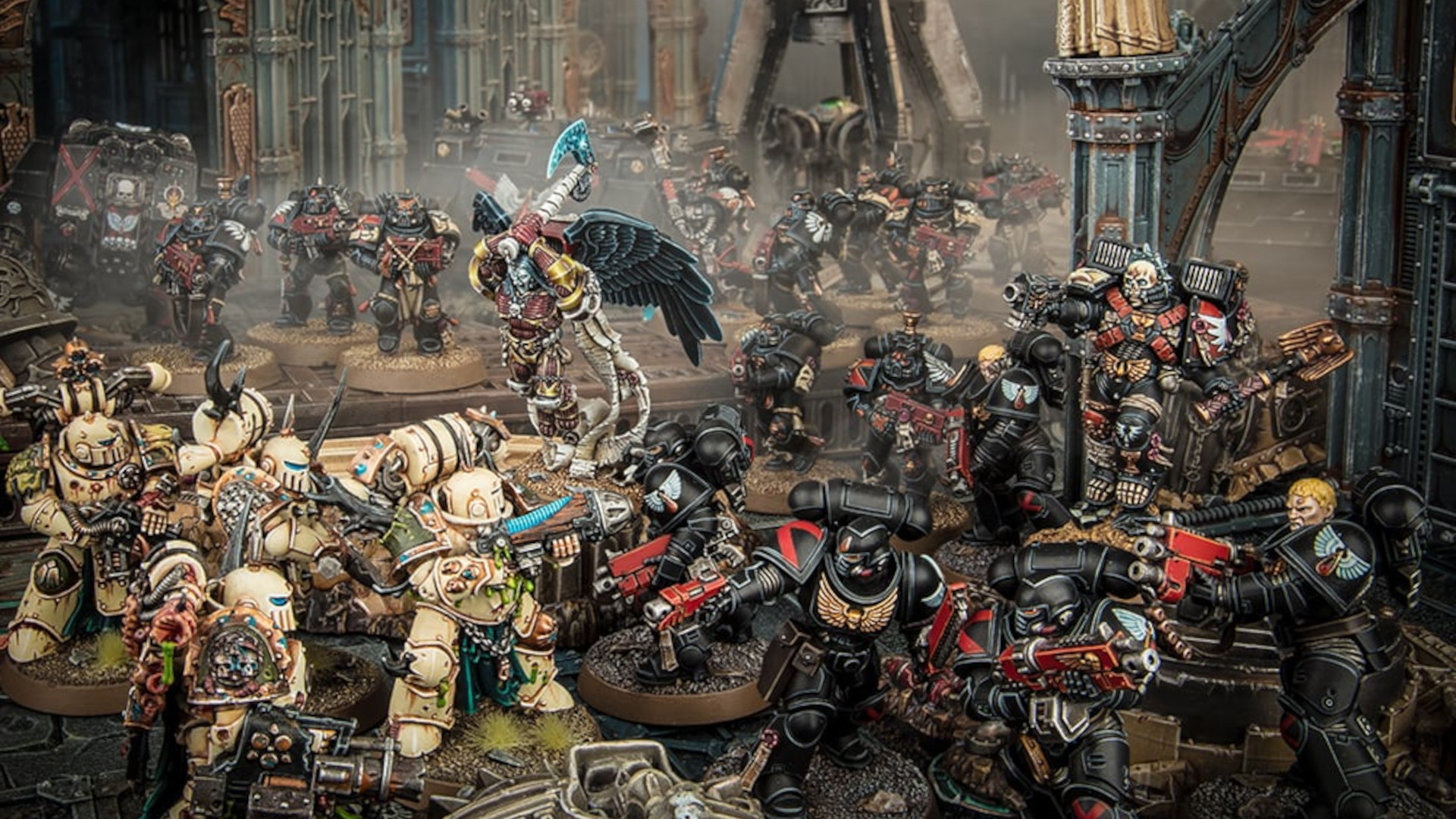Of all the Space Marine chapters in Warhammer 40k, the Blood Angels may have the best claim to be true Angels of Death. They are at once beautiful, noble, selfless defenders of humanity – and violent monsters, tortured by a craving for the blood of those they should protect.
The blood of the Primarch Sanguinius, the Emperor’s angel, flows in their veins, bringing with it supernatural strength and force of will – and agonising psychic visions of his death, and their shameful, secret hunger.
Blood Angels are a truly classic Warhammer 40k faction, appearing in John Blanche’s amazing cover art for the second edition Warhammer 40k starter set. This guide introduces you to their lore and the core features of their army, as well as some of the specialised units you’ll want to consider when building out a Blood Angels force.
Blood Angels Lore
Blood Angels lore is expansive. They were first detailed in the second edition Space Marines Codex Angels of Death, and their story has expanded in codexes and some of the best Warhammer 40k books ever since, not to mention comics like Bloodquest, and some of the oldest Warhammer 40k games on computer (anyone reading old enough to remember Space Hulk: Vengeance of the Blood Angels?)
Blood Angels in the Horus Heresy
In the golden age of the Imperium, when the Emperor of Mankind and his sons waged war across the galaxy, the Blood Angels were the ninth Legion Astartes.
Their Primarch Sanguinius was an almost angelic being, whose great, white wings bore him aloft at the forefront of his host. He was beloved by all, a symbol of the righteousness of the Imperium of Man. The Blood Angels would play a momentous role in the Horus Heresy.
Despite the machinations of Horus Lupercal and the other traitors, Sanguinius and his Sons made it to Terra and fought in the siege of the Imperial palace. As the battle reached its peak, Sanguinius accompanied the Emperor onto Horus’ flagship, The Vengeful Spirit.
Separated from his father, Sanguinius faced Horus alone – and was slain. The repercussions of that terrible murder have haunted the Blood Angels down through the ages.
The Horus Heresy series is famously twisty, so our guide to the Horus Heresy book order should help you pick your way through the maze.
Blood Angels in the 40k timeline
In the Dark Millennium, the Blood Angels and their successors are at the forefront of the Emperor’s armies. They are ferocious warriors and skilled artisans, fighting in every major conflict, from the defence of Cadia to the Ork wars on Armageddon. Yet they have come within a hair’s breadth of extinction.
As the 41st Millennium drew to a close, the Blood Angels found themselves targeted by a tendril of the Tyranid Hive Fleet Leviathan. It seemed the Hive Mind had identified the chapter as a threat and was turning its voracious appetite towards the Blood Angels’ home sector in an effort to destroy them forever.
Chapter Master Dante sent out astropathic messages, requesting that every successor chapter of the Blood Angels make haste to their Primarch’s world of origin – in the end, a force of 20,000 Space Marines gathered in defence of the Baal Sector, even bringing in brotherhoods of marines who had long been spurned by their nigh-heretical indulgence of the Red Thirst.
Despite this gathering of might, the Tyranid Hive Fleet would still have overcome the Blood Angels, had it not been for two, strange interventions, both connected to the fall of Cadia and the opening of the Cicatrix Maledictum warp rift that split the galaxy in two.
A mighty Greater Daemon of Khorne, Ka’bandha, had coveted the Blood Angels’ souls since the time of the Primarch. His daemonic horde might have driven all the Blood Angels to madness, but thanks to the skilled intervention of the might Chief Librarian Mephiston, he instead found himself slaughtering hordes of Tyranids.
When the daemonic incursion finally faltered, it did so like a storm breaking, and the skies above Baal were filled with a new sight – a mighty fleet of the Indomitus Crusade. The Ultramarines Primarch Roboute Guilliman brought with him fresh reinforcements of Primaris Space Marines to rebuild the Blood Angels and their shattered successors.
Despite this influx of new blood, the Blood Angels are in a precarious position. The Baal system lies on the far side of the Cicatrix Maledictum, cutting them off from the light of the Emperor. They are a bastion of light against the darkness – yet, a darkness lingers in their hearts as well.
The Red Thirst
The Blood Angels bear a dark secret, a secret yearning – the Red Thirst, an insatiable appetite for human blood that tugs on the soul of every marine. Some Blood Angels successor chapters have fallen entirely into depravity, becoming vampiric overlords over cowering mortal subjects.
Many Space Marines engage in rituals involving the consumption of blood and flesh. These rituals derive, in part, from the battlefield role that flesh consumption plays for Space Marines, who can absorb the memories of fallen enemies by consuming their flesh. It may be a deformity in the organ that grants this ability, the Osmophagea, that taunts the Blood Angels with their sinister hunger.
Though they fight against their cravings, the Blood Angels cannot escape from them, for they are part of their nature. Even the Angelic Sanguinius felt the hunger for blood. In this way their curse is both profane, and sacred to the Blood Angels cult.
Blood Angels recruit from the ‘tribes of the Blood’ on the moons of Baal Primus and Baal Secundus, the people who raised Sanguinius. The moons of Baal are irradiated deathworlds, and their populations miserable, prone to mutation and genetic disease.
After undergoing ordeals and trials, aspiring Blood Angels drink from the Red Grail, a chalice borne by the chapters’ Sanguinary Priests and filled with the Blood of the Primarch. They will then undergo a full year of surgery inside a life support Sarcophogus, emerging – if they survive – a Blood Angels neophyte.
The Black Rage
When Horus slew his brother Sanguinius, the Angel’s death scream echoed through the Warp and into his sons’ very souls, infecting them with the Black Rage. Every Blood Angel – even the Primaris brethren created by Adeptus Mechanicus archmagos Belisarius Cawl – may find his soul overtaken by the rage of their betrayed Primarch.
Should this happen to a battle-brother, his mind is consumed with ghost memories of Sanguinius’ last moments, haunted by phantom visions of Horus’ flagship and the laughing face of the betrayer. Only Chief Librarian Mephiston is known to have succumbed to the Black Rage and recovered his mind again.
Brothers who succumb are locked away in the Tower of the Lost, where Chaplains attempt to soothe their tortured souls with holy prayer. In times of dire need these brothers are formed up into the Death Company and unleashed, a vanguard of lost souls who fight with the strength and endurance of the damned.
The recent animation series Angels of Death on the Warhammer Plus subscription service does an excellent job interpreting the Black Rage with stylised visuals, as well as being a great, feet-first introduction to several aspects of Blood Angels lore.
Warhammer 40k Blood Angels 9th edition army
Rules for fielding a Blood Angels 9th edition army are found in the Space Marines 9th Edition Warhammer 40k codex and the Blood Angels codex supplement.
The Space Marine ‘dex provides core, army-wide rules and units, while the Blood Angels supplement adds unique units, special characters, additional army-wide benefits, relics, and stratagems, for both the Blood Angels, and their most famous successor chapter, the Flesh Tearers.
The Blood Angels are a combat focused army, able to field extremely powerful characters and specialist melee units. While they retain many options that lend their conventional Space Marine brethren tactical flexibility, the chances are that if you build a Blood Angels army, you’re going to specialise in slicing and dicing.
Blood Angels army wide rules
As Space Marines, Blood Angels employ Combat Doctrines, which grant them improved AP with certain weapons depending on the doctrine that’s active.
They begin the battle in Devastator Doctrine, which grants bonuses with heavy weapons and grenades, then move onto Tactical Doctrine, for bonuses with rapid fire and assault weapons, and finally Assault Doctrine, for bonuses with melee attacks and pistol type weapons.
Additionally, the Savage Echoes ability grants Blood Angels +1 Attack on any turn that they charge while in the Assault Doctrine.
The Chapter Tactics of the Blood Angels and Flesh Tearers grant them +1 to wound on melee attacks on the first round of a combat. Blood Angels are speedier, also gaining +1 to advance and charge rolls, while Flesh Tearers are more lethal, gaining additional AP on melee attack rolls of six.
Blood Angels Combat Patrol
The Blood Angels Combat Patrol contains 15 models, consisting of:
- Primaris Librarian
- Primaris Intercessors x 5
- Primaris Infiltrators or Primaris Incursors x 5
- Primaris Aggressors x 3
- Impulsor APC
- Blood Angels Primaris Upgrade Sprue x 2
This is a rounded start to an army but, as it’s packed with Primaris models, doesn’t bring any of the unique kits associated with the Blood Angels, all of which are firstborn Space Marines. It also doesn’t lean as hard into the close-combat nature of the Blood Angels as it could – though make no mistake, even a ‘balanced’ Blood Angels force can become a melee blender.
Death Company
Those Blood Angels who succumb to the Black Rage are formed up into the Death Company. Armoured all in a panoply of black and led into battle by Chaplains reciting hymns of wrath, two things are certain – neither they, nor their foes, will return from the battle alive.
Models are available for Firstborn Death Company warriors, with and without jump packs. Primaris Intercessors and Primaris Assault Intercessors can be repainted as Death Company Intercessors. The Death Company Dreadnought shows that even venerable ancients can fall to the Black Rage. You can also ‘upgrade’ a Lieutenant or a Captain into the Death Company.
Death Company units are all choppier versions of their non-Death-Company brethren, with additional attacks and access to unique stratagems. Forlorn Fury allows a unit to make a pre-battle Normal Move of up to 12”, while Refusal to Die allows the unit to ignore all wounds it suffers on a 5+.
Sanguinary Guard
The elite veterans of the Blood Angels are the Sanguinary Guard, a brotherhood that dates back to before the Horus Heresy. Clad in ornate, artificer power armour, angel-winged jump-packs, and wielding the finest weapons in the chapter’s armoury, these are the most deadly troops the chapter has to offer.
Starting with three attacks each, a 12” move, a 2+ armour save, a power sword that deals two wounds, and all the melee buffs that come with being a Blood Angel, they are the definition of a melee blender.
While within 6” of the army’s Warlord their Heirs to Azkaellon ability grants them +1 to hit, and the unique Unbridled Ardour stratagem allows them to heroically intervene as if they were a character in your opponents’ charge phase from a distance up to 6”.
This is a great way to control an objective without needing to land on it – place them on the opposite side of the objective and, if your opponent so much as puts a toe on it in their movement phase, you can heroically intervene into them during the subsequent charge phase.
Sanguinary Guard may be the best unit in the Blood Angel codex, which has the amusing side effect that this elite and rare brotherhood is found in almost every competitive Blood Angels list.
Blood Angels Dreadnoughts
There are three, unique Blood Angels dreadnoughts. The Furioso Dreadnought is a regular ‘box’ dreadnought, equipped with two close combat weapons, one of which it can upgrade for the infantry-pasting frag cannon.
The Death Company Dreadnought represents a venerable ancient fallen to the Black Rage, which is so angry it can’t work out how to aim a frag cannon but does get a pair of dreadnought sized power claws (correction… “blood claws”).
Lastly, a Dreadnought Librarian combines the armoured might of a dreadnought with the Psychic Might of a Space Marine Librarian. Casting Wings of Sanguinius to give the fifteen tonne coffin mech the ability to fly is, if not always the right choice, definitely the coolest. It’s also an HQ choice, making it eligible to be a Warlord!
With special thanks to Steve, aka @40ksteve on Twitter, for his Blood Angels pictures

